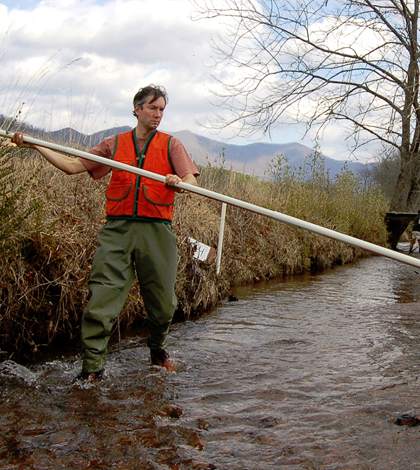Stream Water Quality Up With More Vegetation In Appalachian Mountains

Rhett Jackson and other professors at the University of Georgia, check stream water quality in the Upper Little Tennessee River Basin in the southern Appalachian Mountains. (Credit: University of Georgia)
A recent surveying effort focusing on the health of streams in the southern Appalachian Mountains has found that the key to good stream water quality is surrounding vegetation. And it doesn’t take much — even a single tree can increase the width of a stream and afford creatures more habitat to use.
Researchers from the University of Georgia made the finds after surveying 49 streams in the Upper Little Tennessee River Basin in the southern Appalachians. Forty-five of those streams had low levels of development around them.
The scientists went out with common surveying gear, like poles for measuring stream width and waders so they could stay dry. These tools helped them to see that stream channels without trees tend to become narrower while aquatic habitats in small, fish-bearing streams are reduced in size by two-thirds.
Much of these impacts could be owed to the activities of landowners, scientists found. Where landowners had cut down the forests bordering streams, to turn them into pasture areas or lawns, the structure and even the amount of aquatic habitat changed dramatically.
Part of the Coweeta Long Term Ecological Research Project, the work showed that streams surrounded by forestlands provided more complex habitats and supported more diverse aquatic wildlife than those in the midst of pastures or grassland. Such forested riparian zones are vital for providing woody debris that creates cover and complex habitats for aquatic animals like fish, salamanders and invertebrates.
There are also impacts to water temperatures when vegetation around a stream is removed. More sunlight can hit the stream, raising its temperatures anywhere from 2 to 4 degrees Celsius in the summer, scientists found.
Since trout and salamanders have adapted to cool, shaded and messy streams with lots of wood and nooks and crannies, making a stream simpler and warmer favors fish that would normally dominate streams elsewhere.
Simply put, the existence of trees and other types of vegetation makes for better streams in the southern Appalachians. This was a find that didn’t surprise researchers because the aquatic wildlife in the streams have adapted to the forested stream conditions over time.
Researchers say that many of the floodplains in the study area had been deforested for at least a century, but recent pushes for reforesting the pastures and grasslands could still help. Enacting these types of riparian buffer restorations would be easy — all that landowners have to do is stop mowing the areas, and vegetation will come back on its own.
This could be a difficult thing to sell to some, of course, as there are still widely held beliefs that hold back reforestation efforts. One example is a notion that removing trees helps to improve water quality and make a region more visually pleasing. Organizations like the Mainspring Conservation Trust have been working against those beliefs, and have worked with volunteers to plant trees along streams and encourage landowners to do the same.
Support for the Coweeta Long Term Ecological Research Project is provided by the National Science Foundation.
Top image: Rhett Jackson and other professors at the University of Georgia, check stream water quality in the Upper Little Tennessee River Basin in the southern Appalachian Mountains. (Credit: University of Georgia)




0 comments